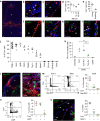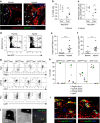Joint morphogenetic cells in the adult mammalian synovium
- PMID: 28508891
- PMCID: PMC5493527
- DOI: 10.1038/ncomms15040
Joint morphogenetic cells in the adult mammalian synovium
Abstract
The stem cells that safeguard synovial joints in adulthood are undefined. Studies on mesenchymal stromal/stem cells (MSCs) have mainly focused on bone marrow. Here we show that lineage tracing of Gdf5-expressing joint interzone cells identifies in adult mouse synovium an MSC population largely negative for the skeletal stem cell markers Nestin-GFP, Leptin receptor and Gremlin1. Following cartilage injury, Gdf5-lineage cells underpin synovial hyperplasia through proliferation, are recruited to a Nestin-GFPhigh perivascular population, and contribute to cartilage repair. The transcriptional co-factor Yap is upregulated after injury, and its conditional ablation in Gdf5-lineage cells prevents synovial lining hyperplasia and decreases contribution of Gdf5-lineage cells to cartilage repair. Cultured Gdf5-lineage cells exhibit progenitor activity for stable chondrocytes and are able to self-organize three-dimensionally to form a synovial lining-like layer. Finally, human synovial MSCs transduced with Bmp7 display morphogenetic properties by patterning a joint-like organ in vivo. Our findings further the understanding of the skeletal stem/progenitor cells in adult life.
Conflict of interest statement
The authors declare no competing financial interests.
Figures








Comment in
-
Stem cells: Synovial stem cells respond to a YAP.Nat Rev Rheumatol. 2017 Aug;13(8):452. doi: 10.1038/nrrheum.2017.93. Epub 2017 Jun 8. Nat Rev Rheumatol. 2017. PMID: 28592897 No abstract available.
References
-
- De Bari C., Dell'Accio F., Tylzanowski P. & Luyten F. P. Multipotent mesenchymal stem cells from adult human synovial membrane. Arthritis Rheumatol. 44, 1928–1942 (2001). - PubMed
-
- Pittenger M. F. et al.. Multilineage potential of adult human mesenchymal stem cells. Science 284, 143–147 (1999). - PubMed
Publication types
MeSH terms
Substances
Grants and funding
LinkOut - more resources
Full Text Sources
Other Literature Sources
Molecular Biology Databases

